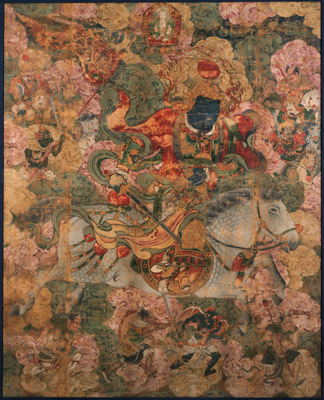ART AND POLITICS IN TIBETAN BUDDHISM
RUBIN MUSEUM OF ART, NEW YORK
February 1 – July 15, 2019
Karl Debreczeny's Overview chapter from the book Faith and Empire, accompanying this exhibition, has been reproduced on asianart.com; to view the article, click here.
“In the West, Buddhism has often been romanticized as an unchanging passive tradition, but historically this was not the case. In Tibet, religion and politics were so intertwined as to be inseparable. For over a millennium Tibetan Buddhism was an active force in politics, both as a means to claim the right to rule and the magical means to take it. Faith and Empire brings together more than 60 remarkable works of art—many from the highest levels of imperial court production—that illuminate the ways in which art and religion had a tremendous impact on politics in the courts of North Asia.”
Karl Debreczeny, Senior Curator at the Rubin Museum
Each "gallery" below shows objects from two chapters in the book of the exhibition: Faith and Empire: Art and Politics in Tibetan Buddhism (see link above).
Click on the gallery number to go to the individual page with further images for each gallery.
| Gallery 1: Karl Debreczeny's first chapter provides a survey of the historical evolution of the involvement of Tibetan Buddhism in the secular powers of Asia throughout history, while Ronald Davidson in the second chapter illustrates the beginnings of this Buddhist tradition in India, showing how "the real story of Indian Buddhism is not its apolitical social-protest stance but its consistent engagement with both small republics and royal courts." |
Karl Debreczeny |
Ronald M. Davidson |
 |
 |
| Gallery 2: In chapter 3, Brandon Dotson describes the "centuries-long process by which Tibetan religious memory transformed Songtsen Gampo (ca. 605–649), a great conquering emperor, into a Buddhist king subsumed into the emanational nexus of Chenrezik, the patron bodhisattva of Tibet"; and Xie Jisheng, in chapter 4, clarifies the crucial role of the "Tangut kingdom of Xixia, a small but significant power founded in 1038 astride the Silk Road" that formed a link in the 11th and 12th centuries between the period of the Tibetan Empire and the later Mongol and Chinese powers. |
Brandon Dotson |
Xie Jisheng |
 |
 |
| Gallery 3: Chapter 5, by Tsangwang Gendun Tenpa, describes the rise of the immense Mongol Empire with its links to the Tibetan Sakya hierarchs, a priest-patron relationship that lasted through the 13th and 14th centuries. Karl Debreczeny, in chapter 6, describes the continuing of the Tibetan Buddhist influence with the predominant regional power in the subsequent reign of the Ming dynasty, which replaced the Mongols in China in the late 14th century but continued the Mongol relationship with the highest-ranking Tibetan Buddhist teachers. |
| Gallery 4: Per Sørensen, in chapter 7, chronicles the rise of the Dalai Lamas in the time of the second rise of the Mongols to power, as well as the relationship that arose between the Mongol Khans and the leaders of the Geluk sect led by the Dalai Lama. In chapter 8, Bryan Cuevas investigates one of the crucial elements of the influence of the Tibetan Buddhists over their political patrons, the widespread belief in their potent magical powers, powers that were believed to extend to the battlefield. |
Per K. Sørensen |
Bryan J. Cuevas |
 |
 |
| Gallery 5: Wen-shing Chou, in chapter 9, describes how "the Manchus adopted Tibetan Buddhism as a state religion after they conquered China from the north side of the Great Wall and founded the Qing dynasty," an adoption that included the linking of the Qing Emperors with Tibetan hierarchs and bodhisattvas. In chapter 10, Johan Elverskog examines the prophecies of the future of Buddhism popular especially among later Mongolians, both that of the future Buddha Maitreya and the apocalyptic myth of the kingdom of Shambhala and the final battle. |
Wen-shing Chou |
Johan Elverskog |
 |
 |
Catalogue | Exhibition Photographs
asianart.com | exhibitions

